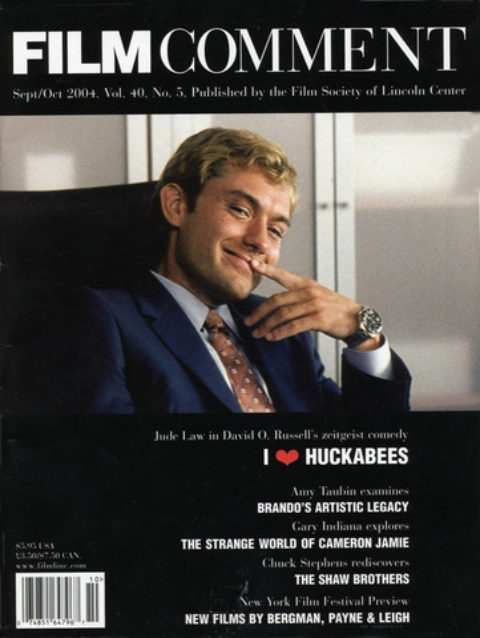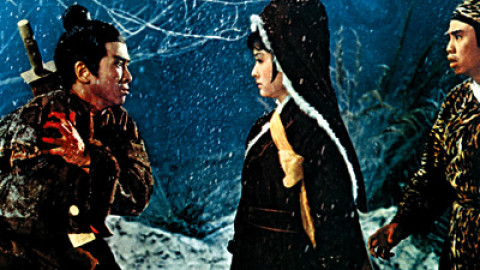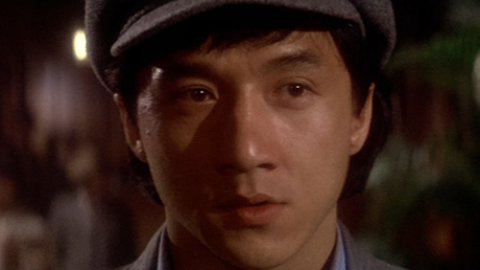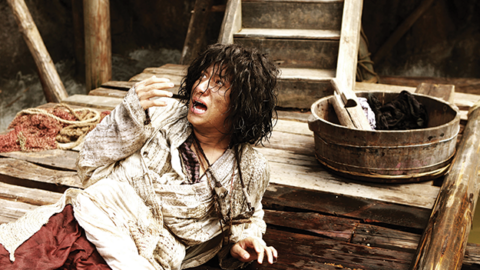
The following are scenes from a modern-day miracle; tomb wafts from an ongoing resurrection; scroll scenes from forgotten legends, illuminated with stardust and leafed with bits of gold:
A turd-brown monkey with a buttocks-shaped brow is flipping an impossibly young Leslie Cheung the bird; later, an impossibly young Maggie Cheung—almost unrecognizable beneath oodles of baby fat—wears a sweatshirt that reads “Moustache” during a “sex scene” that climaxes a montage of Adonis statues, brass balls, and a shot of Leslie sound asleep. An albino dwarf has clamped his legs around the neck of a giant and is squeezing a nauseating jet of acid-turquoise pus out of the enormous black boil on his face; in a related event, a young woman is forced by a centipede to dance an excruciating mambo whenever her father beats his magical bongos. Two martial-arts masters are facing off for a final showdown, but when one delivers what he hopes will be a decisive kick to the other’s vital point, he finds his foot clamped tight in the iron muscle-clutches of his opponent’s mighty groin. A cat burglar’s stealthy progress across jasmine-scented courtyards and moonlit rooftops in what appears to be centuries-old China is interrupted by the appearance of a grinning gargoyle in a cocaine-white zoot suit and a succession of stinger cues and needle drops from tracks by Alice Cooper and Pink Floyd, circa 1972.
Chances are, all of those magical moments—those, and a thousand others just as bold and frequently more bizarre—will come as something new to you, even if they were all committed to celluloid between 20 and 40 years ago. They were gone for a very long while, those moments—locked away behind the walls of one of world cinema’s most fabled walled cities, rarely screened and only occasionally available from list-clutching chopsocky specialists on bootleg videos so murky they might have been intercepted scramble-casts from a Martian moon. But now that they’re back, letterboxed and luminescent, their value is plain to see. The astonishing legacy of Hong Kong’s legendary Shaw Brothers studios—razzle-dazzle musicals, death-steeped melodramas, huangmei diao Chinese opera adaptations, super-noir swordplay sagas, gristle-ribboned urban thrillers, and some of the greatest martial-arts movies ever made—is risen. And a stool-brown monkey shall lead us; behold, the celestial view.
Or rather, the Celestial Pictures view—the company currently engaged in the biggest cine-archeological dig of all time. From a library of more than a thousand titles, and at a cost somewhere in the range of $75 million, Celestial is now in the midst of a five-year project to restore and reissue some 760 Shaw Brothers films from the studio’s mid-Fifties-to-mid-Eighties golden age. Long rumored to have turned to dust in the vaults during the decades since the studio ceased feature-film production and reinvented itself as the television empire TVB 20 years ago, the negatives to nearly all of the Shaws’ classic titles—not just priceless precursors to the Hong Kong film renaissance of the Nineties but cornerstones of Chinese cinema as a whole—turn out to have been remarkably well preserved. As each successive wave of Celestial DVD releases demonstrates, every fuchsia sunset and severed limb is still oozing its original colors, and every flourish of ecstatic camera-whoosh and frantic splice-flurry are still as sharp as the edge on Golden Swallow’s blade. For the aging Shaws acolytes who remember these movies from their childhoods, for the latter-day Tsui Hark and John Woo worshipers who’ve yearned to explore the formative films that their auteur-heroes so explosively remade, and for all the true believers yet to come, it’s a miraculous rolling away of the stone. One-armed swordsmen and oily maniacs, killer clans and castrating courtesans, disco bumpkins and lecherous eunuchs, flying guillotines and mighty Peking men—back from the grave they’ll all come a-marching. Kingdoms and beauties and lovers eternal; three smiles, five venoms, seven golden vampires, and The Sexy Girls of Denmark, too.
Enormous in the diversity of its genre-terrains, authorial fiefdoms, and culture-dividing local languages, the span of the Shaws golden age includes the rise and fall of Mandarin-language wenyi (“literary drama”) costume epics and huangmei diao folk-opera musical hybrids in the late Fifties and early Sixties, an entire sub-history of Cantonese-language youth films and Canto-pop musicals during that same period, and, most prominently, the rise of the new-style wuxia (“martial chivalry”) films in the late Sixties and beyond. Influenced by neighboring action-idioms like James Bond gadget thrillers, nihilist Japanese samurai films, and Spaghetti western existentialism, the Shaws’ wuxia films, first retooled by directors like Chang Cheh and King Hu, and later taken to baroque heights of psychological uncertainty and choreographic excess by Chor Yuan and Liu Chia-liang, reanimated decades-old martial-arts cinematic traditions with dazzling new camera and cutting techniques—not to mention jolts of ultraviolence, social malaise, and occasional nudity. In the Seventies, only Bruce Lee was able to make a brief, David-like stand against the Goliath Shaw Brothers, who continued to dominate martial-arts movies long after the strains of “Kung Fu Fighting” had faded away.
As central as westerns to the development of Hollywood cinema, wuxia films have been at the heart of Chinese cinema since at least the beginnings of the Shanghai film industry, in the mid-Twenties. Stories about fighting scholars and female avengers, and supernatural displays of martial prowess from “palm power” blasts to “deadly sound wave” decimations, have long since become commonplace. By the early Sixties, any swordsman worth his weightlessness in gold was already attempting to scamper up walls and leap over opponents with wire-rigged ease, though the tawdry production values of the Cantonese films in which such feats typically appeared tended to favor gravity over awe. In 1965, spurred by the local popularity of Sergio Leone’s Dollars trilogy and the blind Zatoichi’s visionary triumphs over adversity, not to mention the plummeting popularity of its huangmei diao musicals, the Shaw Brothers’ Mandarin-language division announced the beginning of its “Color Wuxia Century”—a new action era designed to emphasize more realistic fight choreography than its Cantonese cousins, and dynamic applications of modern camera technology (in particular that most assertive of cinematic gadget-weapons, the zoom lens) and accelerated editing. Whereas the shot-length average in a typical Hong Kong film from the Fifties was between eight and 11 seconds, Planet Hong Kong author David Bordwell clocks an action era average of only seven seconds; by the Seventies, the shot duration in many Shaws films was down to four.
That the first film of this “color” century, Tiger Boy (66)—the directorial debut of former film critic and longtime Shaws huangmei diao scriptwriter Chang Cheh—was shot in black-and-white seems somehow apropos to the auteurial career it inaugurated. Though he would go on to make some of the most financially successful films in Shaws history, Chang worked with an extremely limited palette of visual and thematic pleasures throughout his career; a dirt road, a couple of he-warriors stripped to the waist and slathered with oil, and the opportunity to sever their limbs or gouge out their bowels were often all it would take to satisfy the cravings of this former mentor of John Woo’s elemental cinematic view. For some, a cartoon castration-anxiety title like One-Armed Swordsman (67)—the director’s first blockbuster contribution to the Shaw’s wuxia revival—may sound like a scrape across the blackboard of Psychology 101, but the yang gang (“staunch masculinity”) ethic of Chinese machismo that underlies Chang’s films nevertheless continues to appeal to martial-arts mavens and text-explicating homoerotica aficionados alike. Had King Hu, Chang’s only in-house competition at Shaws in the mid-Sixties, not left the studio immediately after the competition of his, and the cycle’s, first masterpiece, Come Drink with Me (66), history might have had a different lilt. Chang was all about heroes, Hu was all about grace: the fleetness of motion and lightness of touch throughout Come Drink with Me‘s path-marking story about a cross-dressing swordswoman and a deceptively drunken master would continue to be aped to lesser effect by other Shaw directors for years. Hu, meanwhile, moved to Taiwan and made his first independent showstopper, Dragon Inn (66)—a film so undeniably dazzling that Shaws had no choice but to distribute it anyway, whatever the sting of having lost one of its greatest potential behind-the-camera stars.
In the Seventies, two additional wuxia masters would arise to crosshatch the genre’s image with new shadings. Veteran director Chor Yuan had, like many Shaws directors, a lengthy résumé that well predated his tenure with the studio: he’d been making Cantonese melodramas since the late Fifties, some 70 titles in all. He joined Shaws in 1970 and immediately began cranking out between two and five films a year; by 1973, he’d managed to single-handedly revive the Cantonese-language unit at the studio with an old-fashioned ensemble comedy called House of 72 Tenants (73), and produce a masterpiece in the hyper-ornate whorehouse-wallpaper mode that for the next decade he’d continue to claim as his own: Intimate Confessions of a Chinese Courtesan (72).
Intimate Confessions details every lurid lesson in the education of an angel-witch named Ainu, who’s abducted as an innocent, deflowered by lecherous mandarins, and put to work for the stunning Madame Chun, a descendant of Barbara Stanwyck’s superdyke mamasan in Walk on the Wild Side. Yuan’s film both provided the revenge-seeking prototype for a wanton Nineties grindhouse classic like Naked Killer and paved the way for the moonlit adaptations of wuxia modernist Gu Long’s novels that Chor would spend the rest of the Seventies working on. Paranoid and fetish-filled, Chor/Gu films like Killer Clans (76), Death Duel (77), and The Magic Blade (76) teem with rope-tethered heroes and swords-maniacal deceptions; lovers and archenemies meet in butterfly-filled forests and under the blood shadows of rose-red moons, itinerant killers sport serapes and twirl hinged sabers as if they were six-shooters from some parallel dynasty, and soundtracks surge with swirly sword-shhinnngs and doubled death-grunts until someone finally kicks the Echoplex to death. The seeds of Wong Kar-wai’s Ashes of Time are sprinkled here.
A real-life descendant of the legendary martial-arts master Wong Fei-hong (the character incarnated by Jet Li in Tsui Hark’s Once Upon a Time in China trilogy), actor-fight choreographer-director Liu Chia-liang also came of age in the Cantonese cinema of the Fifties. Hired as a fight coordinator by Shaws just as its wuxia century was announced, Liu became Chang Cheh’s regular collaborator for most of a decade; when the two fell out in the mid-Seventies, Liu’s directorial debut, The Spiritual Boxer (75), set martial-arts films off in a direction that would be variously hated and adored by audiences to come: he made them funny, and cued star-auteurs like Sammo Hung and Jackie Chan to do the same. Not that mirth was something one would expect from looking at Liu’s granite-featured face: as ghoulish a mug as Boris Karloff or Lon Chaney, Liu would often turn up in bit parts as an implacable assassin, and when his filmography began to alternate between kung fu comedies and portraits of battle-scarred psychosis like the extraordinary Eight Diagram Pole Fighter (83), no one was surprised. Occasionally, Liu would merge the two concerns within a single film: who’d have guessed from the title of Executioners of Shaolin (77) that a kung fu Ozzie and Harriet was about to unfold? Revolutionizing fight choreography in ways that have yet to be surpassed, Liu made lightning-fast movements not only intelligible but indelible, and the pas de deux he designed for competing modes of combat-short/fast Southern Shaolin styles vs. wide/weaving Northern Wudang styles-are as essential to any study of dance in cinema as the disparate dazzlements of Fred Astaire or Maya Deren.
Given their statistical and stylistic centrality to Chinese cinema, it’s only natural that Shaws’ wuxia films would be the first of the Celestial spheres to come back into focus, with last year’s chopsocky-centric “Heroic Grace” series—a traveling program of Shaw and non-Shaw titles, as well an essential catalog-primer filled with essays by Hong Kong cinema sifu like David’s Bordwell and Chute, all organized by UCLA’s Film and Television Archive—providing an eye-opening inaugural glimpse. But today, as an ever-broader range of the entire Shaws output once again becomes available to festival programmers internationally, there are those who worry that perhaps the wuxia wing of the studio’s output is being overvalued and would rather we rediscovered major wenyi directors like Li Han-hsiang, whose 1963 musical The Love Eterne—a kind of cross-dressing Romeo and Juliet—remains one of the most popular Chinese movies ever made. But with fewer than half of those 760 titles yet available for scrutiny, Planet Shaw remains a bit like the elephant as described by five blind men: one guy grabs the trunk and thinks he’s found a snake, another hugs a leg and thinks he’s found a tree, and so on, until the last guy sticks his hand up the elephant’s ass, and is understandably at pains to detail the riches that he finds. So, yes, by all means rediscover The Love Eterne for its relevance to later Queer Studies cornerstones like The East Is Red and Peking Opera Blues; go ahead and indulge in the costume grandeur of the sub-DeMille spectacles that Li—whose style Chang once described as “overlordly”—brought to pageants like The Kingdom and the Beauty (59) and Beyond the Great Wall (64). But spare a thought for that guy at the back of the elephant, and remember that Li also made plenty of softcore “duplicity” films with titles like Love Swindlers (76), Crazy Sex (76), and That’s Adultery (75) during the high and low tide-flows of his Shaw Brothers career.
Indeed, the true scope of the Shaw story will take historiographers and star biographers several more years to tell; even the 400-page phone-book-size volume published as recently as last year by the Hong Kong Film Archive, The Shaw Screen, bears the cautionary subtitle “A Preliminary Study.” Mainly, though, it’s the films—particularly the youth films from the studio’s Cantonese unit in the late Fifties and the crime films of the late Seventies by vaunted directors like Kuei Chih-hung—that are still missing; the chronological and industrial contours are already clear. The prehistory of the Shaw Brothers’ story stretches back to Twenties Shanghai, with eldest brother Runje, formerly a successful lawyer, opening an independent production company called Unique, and second-youngest brother Runme buying up movie theaters in Singapore and Malaysia as the first step in the family’s master plan for distributing Chinese movies to Chinatowns throughout the world. In an evolution that lasted 80 years, the Shaws’ various-titled companies remained at the forefront of each new development in Chinese filmmaking, navigating professional and political sea changes that included everything from shifts between Cantonese and Mandarin-language film production and back again to the Japanese occupation of Hong Kong during WWII. But it wasn’t until the late Fifties, when youngest brother Run-Run became company head and began construction of the studio’s permanent home, Movie Town-which, when finally completed in 1967, would contain some 850,000 square feet of sound stages, processing labs, residences for casts and crews, and a back lot strewn with reproductions of temples, fortresses, bridges, boudoirs, and battlefields from 5,000 years of Chinese history-that Shaw Brothers hit the stride it maintained for the next three decades, presiding over chains of movie theaters and amusement parks throughout Southeast Asia and producing 40 feature films a year.
Modeled on the production systems of the “Big Five” Japanese studios (Shochiku, Daiei, Toho, Toei, and Nikkatsu), the house that Run-Run built maintained an ongoing interest in regional and international co-production. With the members of the Big Five—all of whom Shaws would eventually outlive—the studio played a prominent role in the development of the Southeast Asian Film Festival, which was planned as a regional rival to Venice and Cannes and established in the wake of Rashomon‘s international success, and survived as a thriving festival/marketplace hybrid until the end of the Sixties. The festival facilitated pond-hopping between various country’s talent pools, eventually allowing Shaws to import Japanese “sun tribe” specialists like Inoue Umetsugu and Kô Nakahira—whose Crazed Fruit Oshima had once praised for the proto-New Wave agonies of its screaming seagulls and corpse-grinding speedboat motors—to helm musicals and spy flicks for the studio on a full-time basis. But long before there was a Zatoichi Meets the One-Armed Swordsman, Kenji Mizoguchi had met the Shaw Brothers, and together they’d made Princess Yang Kwei Fei, back in 1955. Over the course of time, everyone from Monte Hellman (imported for the lumbering 1974 Stuart Whitman/Ti Lung team-up Call Him Mister Shatter) to Shin Sang-ok (the veteran South Korean filmmaker most famous for having been kidnapped by North Korean president Kim Jong Il, the most powerful film buff in the non-free world) would come to make films for Run-Run, an ever-canny investor whose psychotronically diversified portfolio included Hammer horror flicks, blaxploitation one-offs, Tai-Pan (86), Meteor (79), and Ridley Scott’s Blade Runner (82).
With crossover tendencies as constantly curious as those, it’s no wonder Shaw Brothers films continue to exert as powerful and far-flung an influence on audiences and young filmmakers now as they did when they were still being made. When contemporary filmmakers as aesthetically disparate as Quentin Tarantino and Tsai Ming-liang both begin their most recent films with Shaws-related fanfares, populate them with former Shaws players like Gordon Liu, and predicate them on films by directors like King Hu and characters like the white-eyebrowed monk Pai Mei (warrior-lord of the foot-clamping ass-crack), it’s clear the Shaw Brothers legacy isn’t just as a spooky bunch of silver nitrate specters roaming the haunted movie houses of yore but as a living concern. Even Sir Run-Run Shaw himself, who turns 97 this year, refuses to give up the ghost, outlasting a number of crucial Shaw-film figures (Chang Cheh, actor Lo Lieh) who passed on just as the Celestial resurrection was getting under way. A world within a world, Planet Shaw continues its orbit unabated by evolving fashions or waves of fickle taste. Tarantino may have relished the Shaws-like studio working conditions in Beijing during the production of Kill Bill as much as he enjoyed taking ecstasy and raving away his nights off on the Great Wall of China, but inside the production fortress of Movie Town, the Shaws had a plaster of paris replica of that Great Wall all their own. Gone but never forgotten, and now—at long last—back again, the house that Run-Run built flickers with life once more, a celluloid joint out of time.








